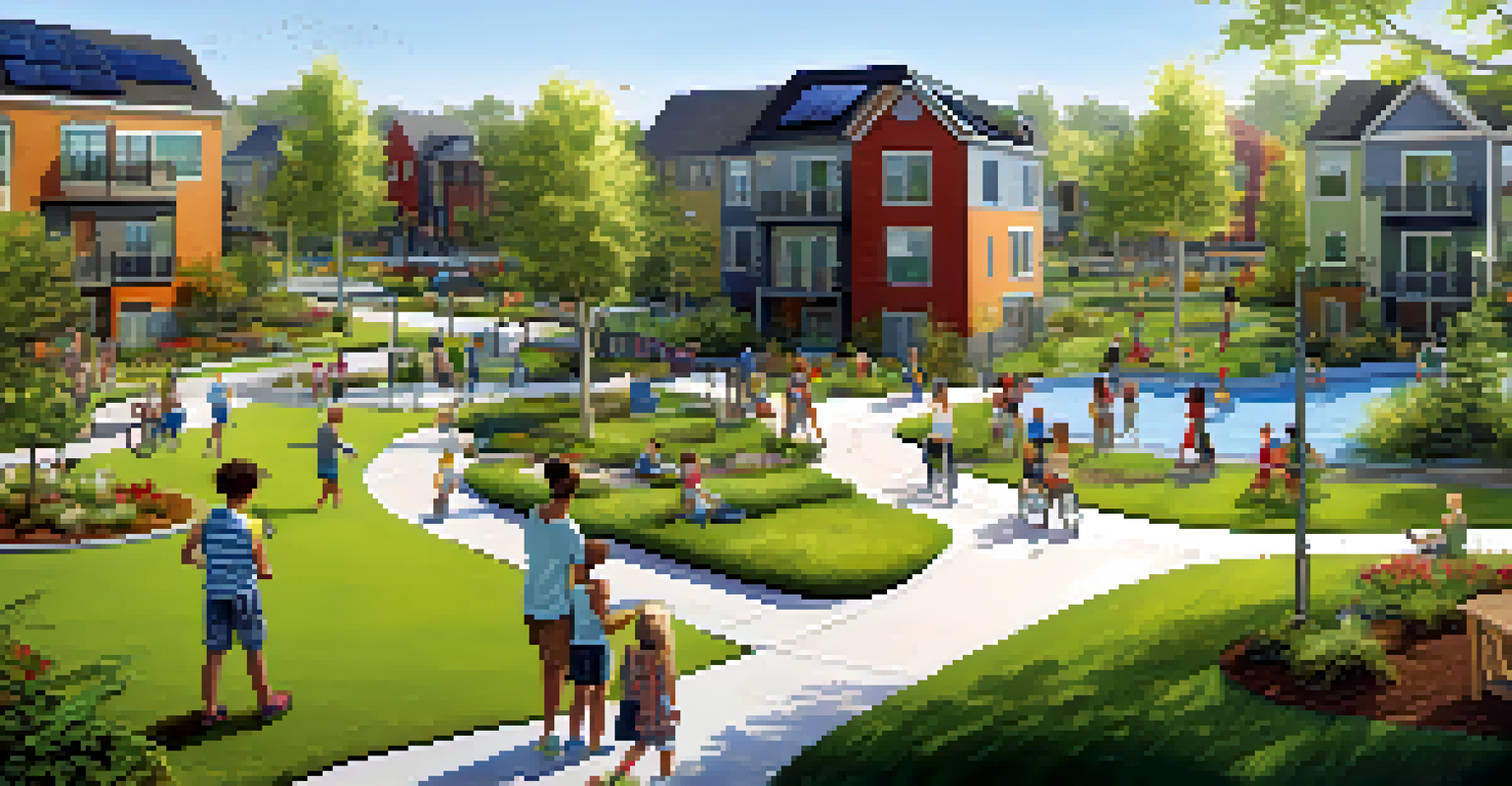Exploring Eco-Friendly Construction Techniques for Energy Savings

Understanding Eco-Friendly Construction Basics
Eco-friendly construction focuses on minimizing environmental impact while creating sustainable buildings. This approach prioritizes energy efficiency, resource conservation, and overall sustainability. By using renewable materials and energy-efficient designs, builders can significantly reduce their carbon footprint.
The greatest threat to our planet is the belief that someone else will save it.
One key aspect of eco-friendly construction is the use of sustainable materials, such as bamboo or recycled steel, which can be both durable and environmentally friendly. Additionally, energy-efficient designs, like passive solar architecture, utilize natural light and heat to reduce energy consumption. Understanding these fundamentals is essential for anyone looking to embrace green building practices.
Ultimately, eco-friendly construction techniques not only benefit the environment but can also lead to long-term savings for homeowners. As energy costs continue to rise, investing in sustainable building practices becomes increasingly attractive for both builders and consumers.
The Role of Energy Efficiency in Construction
Energy efficiency plays a pivotal role in eco-friendly construction, focusing on reducing energy consumption throughout a building's lifecycle. By incorporating energy-efficient designs and technologies, such as high-performance insulation and energy-efficient windows, builders can create structures that consume significantly less energy. This not only lowers utility bills but also enhances comfort within the space.

For example, a well-insulated home can maintain a stable temperature, reducing the need for heating and cooling systems to work overtime. This not only saves money but also extends the lifespan of these systems. Moreover, energy efficiency contributes to reducing greenhouse gas emissions, making it a win-win situation for both homeowners and the planet.
Emphasizing Energy Efficiency
Energy-efficient designs and technologies significantly reduce energy consumption, lowering utility costs and enhancing comfort.
Investing in energy-efficient construction techniques can also increase property value. Homes that boast energy-saving features are often more attractive to buyers, particularly in a market that increasingly values sustainability.
Incorporating Renewable Energy Sources
Renewable energy sources, such as solar, wind, and geothermal, can play a significant role in eco-friendly construction. By integrating these systems into building designs, homeowners can generate their own energy, leading to substantial cost savings over time. For instance, solar panels can provide a reliable source of electricity, reducing dependence on non-renewable energy sources.
Sustainable building is not just a trend; it is a necessity for the future of our planet.
In addition to solar energy, geothermal heating and cooling systems utilize the earth's constant temperature to regulate indoor climates efficiently. This method not only enhances energy efficiency but can also lower energy bills significantly. Incorporating renewable energy sources into construction plans is an effective way to promote sustainability.
As technology continues to evolve, the integration of renewable energy in construction becomes more accessible and affordable. This shift not only benefits individual homeowners but also contributes to a larger movement towards a sustainable future.
Utilizing Sustainable Materials in Construction
The choice of materials is crucial in eco-friendly construction, as sustainable materials can drastically reduce a building's environmental impact. Options like reclaimed wood, bamboo, and recycled materials are increasingly popular for their durability and low ecological footprint. These materials not only help conserve resources but also add unique character to a home.
For example, using reclaimed wood not only reduces waste but also provides a rustic charm that many homeowners find appealing. Furthermore, sustainable materials often require less energy to produce and transport, making them a more environmentally friendly choice. By selecting materials wisely, builders can create beautiful, functional spaces that minimize environmental harm.
Utilizing Sustainable Materials
Choosing sustainable materials like reclaimed wood and bamboo minimizes environmental impact while adding unique character to buildings.
Educating consumers about the benefits of sustainable materials is essential for fostering a culture of eco-friendly construction. As demand for these materials increases, more manufacturers are likely to produce them, further driving sustainability in the construction industry.
Implementing Passive Solar Design Principles
Passive solar design is an innovative approach that harnesses the sun's energy for heating and lighting without the use of mechanical systems. By strategically positioning windows, overhangs, and thermal mass within a building, architects can enhance natural light and warmth. This design principle not only reduces energy consumption but also creates a more comfortable living environment.
For instance, a home designed with large south-facing windows can capture sunlight during the winter months, naturally warming the space. Conversely, overhangs can provide shade in the summer, keeping the interior cooler. By utilizing the sun's energy effectively, homeowners can minimize reliance on artificial heating and cooling systems.
Incorporating passive solar design principles is an excellent way to achieve energy savings while enhancing the aesthetic appeal of a home. As more builders recognize the benefits of this approach, we can expect to see a greater emphasis on integrating passive solar design into new construction projects.
The Importance of Water Conservation in Building
Water conservation is a critical component of eco-friendly construction, as buildings consume a significant amount of water throughout their lifecycle. Incorporating water-efficient fixtures, rainwater harvesting systems, and drought-resistant landscaping can dramatically reduce water usage. These practices not only help preserve this precious resource but can also lead to significant cost savings.
For example, installing low-flow faucets and toilets can reduce water consumption without sacrificing performance. Additionally, rainwater harvesting systems capture and store rainwater for irrigation and other non-potable uses, further decreasing reliance on municipal water sources. By prioritizing water conservation in construction, builders can contribute to a more sustainable future.
Promoting Sustainable Communities
Eco-friendly construction fosters the development of sustainable communities that prioritize energy efficiency and resource conservation.
Educating homeowners about the importance of water conservation in building practices is essential for promoting responsible resource management. As awareness grows, we can expect to see more innovative solutions aimed at reducing water consumption in the construction industry.
Creating a Sustainable Community through Eco-Friendly Building
The impact of eco-friendly construction extends beyond individual buildings; it can contribute to the development of sustainable communities. By prioritizing green building practices, developers can create neighborhoods that emphasize energy efficiency, renewable energy, and resource conservation. This holistic approach fosters a sense of community while promoting environmental responsibility.
For instance, communities that incorporate green spaces, walkable areas, and shared renewable energy sources can enhance residents' quality of life. These features not only support sustainability but also encourage social interaction and well-being. By building with sustainability in mind, developers can create vibrant, resilient communities for future generations.

As more consumers seek eco-friendly options, the demand for sustainable communities will continue to grow. This shift presents an exciting opportunity for builders and developers to rethink traditional construction practices and embrace innovative solutions that benefit both people and the planet.